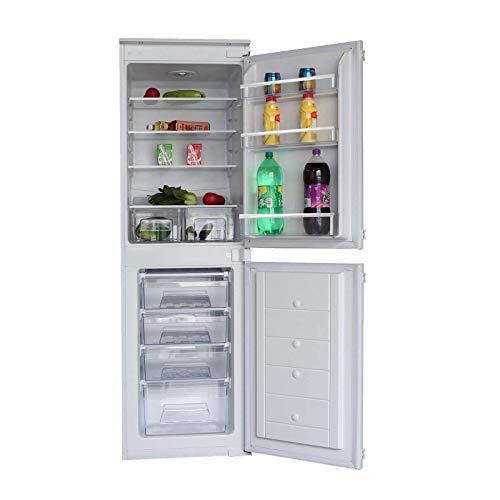
Buy Fridge Freezer
Add a review FollowOverview
-
Founded Date November 12, 1922
-
Sectors Law and Legal Services
-
Posted Jobs 0
-
Viewed 21
Company Description
It’s Time To Extend Your Fridges And Freezers Options
Understanding Fridges and Freezers: The Essential Kitchen Appliances
Fridges and freezers are 2 of the most important devices in modern kitchens. These appliances serve a crucial role in food conservation and waste reduction by guaranteeing that perishable items remain fresh and safe for intake. This post explores the different types of fridges and freezers, their performances, and crucial factors to consider for selection and maintenance.
Types of Refrigerators
The market offers a variety of refrigerator types, each designed to fulfill different consumer requirements. Below is a list of the most typical types of fridges:
-
Top-Freezer Refrigerators
- Most typical type.
- Freezer compartment lies above the refrigerator section.
- Normally more economical and energy-efficient.
-
Bottom-Freezer Refrigerators
- Freezer is situated at the bottom.
- Allows simpler access to fresh products at eye level.
- Typically features pull-out drawers for much better organization.
-
Side-by-Side Refrigerators
- Refrigerator and freezer sections are surrounding.
- Suitable for narrow kitchens and permits easy access to both compartments.
- Typically comes with water and ice dispensers.
-
French Door Refrigerators
- Combines a bottom freezer with double doors at the top.
- Offers sufficient storage and stylish designs.
- Frequently consists of functions like temperature-controlled drawers.
-
Compact Refrigerators
- Smaller sized size suitable for minimal areas.
- Commonly used in dormitory, little apartment or condos, or as secondary fridges.
Table 1: Comparison of Refrigerator Types
| Type | Benefits | Disadvantages | Common Size |
|---|---|---|---|
| Top-Freezer | Inexpensive, energy-efficient | Less convenient access to the freezer | 14-30 cu. ft. |
| Bottom-Freezer | Much easier access to fresh food | Freezer can be more difficult to organize | 19-30 cu. ft. |
| Side-by-Side | Easy gain access to, water/ice dispenser | Narrow vs. storage area | 22-30 cu. ft. |
| French Door | Elegant, spacious, arranged | More expensive | 20-30+ cu. ft. |
| Compact | Space-saving, portable | Restricted storage | 1.7-5.5 cu. ft. |
Types of Freezers
Freezers are a similarly important appliance for food conservation. They come in numerous styles designed to fit various home requirements. Think about the list below types:
-
Upright Freezers
- Run like a basic refrigerator with vertical storage.
- Easier to organize with racks and compartments.
-
Chest Freezers
- Big, horizontal design generally using more storage area.
- Maintains temperature levels much better during power outages.
- More energy-efficient than upright models.
-
Portable Freezers
- Compact systems ideal for outdoor activities or small areas.
- Often used for camping journeys or as short-lived storage.
Table 2: Comparison of Freezer Types
| Type | Advantages | Downsides | Typical Size |
|---|---|---|---|
| Upright Freezer | Easier to organize | Less energy-efficient, more flooring area | 5-20 cu. ft. |
| Chest Freezer | Holds more items, energy-efficient | Harder to arrange | 5-25 cu. ft. |
| Portable Freezer | Compact and flexible | Restricted storage capacity | 1-10 cu. ft. |
Key Features to Consider
When picking a fridge or freezer, customers must remember numerous functions that can improve performance:
- Energy Efficiency: Look for designs with the ENERGY STAR certification to save money sale on fridge freezers Uk electrical power bills.
- Storage Capacity: Evaluate storage needs based on family size and consuming practices.
- Temperature Control: Some home appliances offer digital controls for accurate temperature settings.
- Adjustable Shelving: Customizable shelving enables ideal company.
- Water and Ice Dispenser: Offers benefit however can take up valuable area inside.
- Sound Level: Sound rankings can influence comfort, specifically in open-concept homes.
Benefits and drawbacks of Having a Fridge and Freezer
While fridges and freezers are indispensable technologies, they also have certain advantages and downsides:
| Pros | Cons |
|---|---|
| Maintain food life expectancy and reduce waste | Need routine maintenance |
| Allow bulk purchasing and meal prepping | Can be costly to acquire and run |
| Deal benefit and fast access to food | Inhabit considerable kitchen space |
Upkeep Tips
To ensure longevity and optimum efficiency of fridges and freezers, consider the following upkeep tips:
- Regular Cleaning: Clean the exterior and interior regularly to prevent buildup of dirt and bacteria.
- Check Seals: Inspect door seals regularly for leakages to maintain effectiveness.
- Temperature level Settings: Keep the fridge at 34-38 ° F and the freezer at 0 ° F for optimum food conservation.
- Thaw as Needed: Chest freezers ought to be defrosted frequently to preserve efficiency.
- Clear Air Vents: Ensure that air flow isn’t obstructed to improve energy efficiency.
Frequently asked questions About Fridges and Freezers
Q1: How long can food be stored in a freezer?A: Most foods can be kept in a freezer for numerous months. Meats and poultry typically last 4-12 months, while vegetables can last approximately 8-12 months.

Q2: How typically ought to I clean my fridge and freezer?A: It is recommended to clean your fridge and freezer every 3 to 6 months, or as required when spills take place. Q3: Can I put hot food directly in the fridge?A: It is recommended to cool hot food to space temperature before placing it in the fridge to prevent
raising the temperature level inside the home appliance. Q4: Why is my fridge running constantly?A: This could be due to a malfunctioning thermostat, clogged up coils, or door seals that aren’t working effectively. Fridges and freezers are important
assets to modern households, offering vital services for food storage and preservation.
Comprehending the numerous types, functions, and upkeep requirements can help customers choose the best devices for their needs and optimize their functionality. Accepting energy-efficient designs not only supports sustainable practices however also adds to substantial savings on utility costs, making notified choices more essential than ever.
